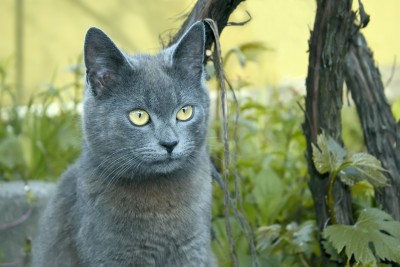One of the most common frustrations for cat owners, especially in multi-cat households, is inappropriate urination by their cat or cats. Urine spraying is one such frustration.

Feline urine spraying refers to the situation in which a cat eliminates urine in a vertical stance directly against a wall or other upright object. During an episode of urine spraying, the offending cat is often seen to stand on all 4 feet, tread the ground and show an elevated quivering tail whilst a stream of urine is deposited against the chosen object. Although feline urine spraying is generally abhorred by owners, it can be a normal urinary elimination technique in some cats. However, feline urine spraying is generally regarded as a communication tool between cats and as a symptom of anxiety or aggression. Many owners are surprised to learn that not only can feline urine spraying be normal in some cats, but that both male and female cats may spray.
Often owners find urine in inappropriate places around the house and are not sure whether the cat has urinated out of the litter box or sprayed as a marking behaviour. It is important to determine which the case is before implementing combative actions. Generally, a determination can be made by comparing the volume of urine in the wet puddle and looking for any indication of urine on a vertical surface. Inappropriate urination outside the litter box will involve a large volume of urine in a puddle formation. Spraying is indicated when a small volume of urine is expressed and where there is evidence of a urine mark at the same height as the standing cat with a drip pattern down the wall or object sprayed. There may or may not be a secondary puddle on a lower surface due to dripping from the sprayed area. Cats that spray usually still use the litter box appropriately for both urination and defecation.
Why Do Cats Spray?
Cats use scent marking as a communication tool. Scent marking can identify a cat's territory and make the cat feel comfortable in its own environment. Cats can mark in several ways, namely with facial scents and urine marking. Obviously facial scent marking is generally more acceptable to owners than urine spraying.
Whilst marking is a normal communication tool for cats, it can become an overused tool in cats suffering from anxiety, aggression and stress. Where inter-cat aggression is noted in the household, urine marking may be more prevalent. Owners need to be aware of such aggression as this is an important consideration in managing urine spraying. Any changes in the local environment may also cause a cat to start spraying, for example the presence of a new or aggressive cat in the neighbourhood encroaching on the cat's territory. This encroachment may be real or just perceived by the cat, for example seeing the other cat through a window. Other triggers for a cat to start urine spraying might be a change of address or increased noise and busyness in the home due to a change in the owner's routine. Some spraying behaviours may have a medical basis and these should be investigated by your veterinarian. Owners need a full history of the behaviour and possible issues involved as noted above to help the veterinarian fully assess the situation and determine which pet medications may be necessary.
Managing Spraying Behaviours
Since hormones are known to play a role in feline urine spraying, and since male cats and female cats on heat (in oestrus) are more likely to spray, desexing is often the first suggestion in the management plan for this issue. Studies show that a large proportion of male cats will cease urine marking once castrated. Sometimes this alone is enough intervention to prevent the behaviour.
However, where inter-cat aggression is involved or where the offending cat is part of a multi-cat household, behavioural management cat training will often also be required. Separating the cats, deterring foreign cats from entering the yard in areas seen by the offending cat through the window, such as the provision of adequate individual litter boxes may all be of assistance. You could consider the use of pet supplies such as Stop Repellent Spray which keeps cats away from particular indoor or outdoor areas which may assist with changing unwanted spraying behaviours.
Any area which has been sprayed must be thoroughly cleaned with water and a mild soap. Avoid any cleaning agent containing ammonia compounds. Pet products which disguise or eliminate the scent are also worthwhile.
It is essential to address any anxiety related disorder in any cat which is urine spraying and does not respond to desexing alone. The first modification is to encourage facial marking instead of urine marking. The use of Feliway spray and Feliway plug-in vaporisers can be highly effective in these cases. Feliway mimics feline facial pheromones. It is sprayed on any surface previously urine marked by the cat and on any other prominent surfaces. Cats generally will not urine mark in locations that they have previously marked with facial pheromones, thus Feliway can break the urine marking cycle. Feliway is reported to assist with emotional stabilisation of the anxious or stressed cat. Another anti-anxiety pet medication that may prove helpful is Vetalogica's Canine and Feline Tranquil Formula.
For cats which are still highly anxious despite the above interventions, your veterinarian might prescribe anti-anxiety pet meds. These must be used in accordance with veterinary directions and under strict veterinary control.
Whilst feline urine marking or urine spraying is a natural communication tool used by cats, it is often unacceptable to many cat owners. Desexing the cat, encouraging facial marking in preference of urine marking and providing solutions to inter-cat social issues often work in combination to manage this issue. However, owners should discuss the issue with their veterinarian to seek specific advice for their individual cat/s to ensure that any underlying medical issue is not overlooked.